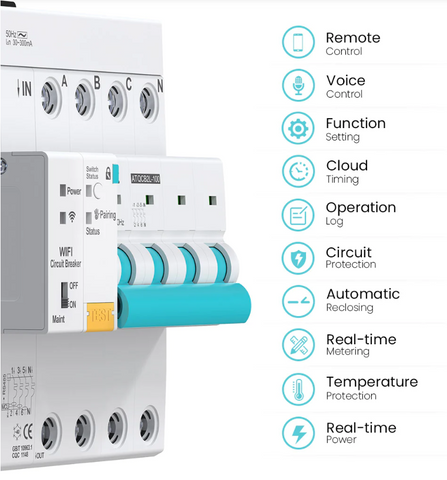Smart breaker: 5 Problems You Could Face
In the age of smart homes, where every aspect of our daily lives is interconnected and automated, smart breakers have emerged as a promising technology. These advanced electrical devices aim to enhance safety, efficiency, and convenience in our homes.
However, like any new technology, smart breakers are not without their challenges. In this blog, we will delve into five potential problems you could face when using smart breakers and how to mitigate them.
5 Problems You Could Face with Smart Breakers

Smart breakers represent a significant advancement in home automation and electrical safety. They offer the potential to revolutionize how we manage and monitor our electrical systems.
Nevertheless, it's essential to approach the adoption of smart breakers with a clear understanding of the challenges they present. To ensure smart breakers integrate smoothly and securely into your smart home, consider compatibility, reliability, security, installation, and cost factors. Make informed decisions and take the necessary steps for a seamless integration process.
1. Compatibility and Integration Issues
Smart breakers often rely on different communication protocols and technologies, such as Wi-Fi, Zigbee, or Z-Wave, to connect with other devices and systems in your home. This can lead to compatibility issues, especially if your existing devices or home automation systems use different protocols. Ensuring seamless integration may require additional devices or software solutions, potentially increasing complexity and costs.
2. Reliability and Connectivity Problems
The reliability of a smart breaker largely depends on its connectivity to the network. If your Wi-Fi signal is weak or prone to disruptions, your smart breaker's performance may be compromised. Power outages could also disrupt the communication between your smart breaker and the controlling app, leaving you without control over your electrical system during critical times.
3. Security Concerns
With the increased connectivity of smart breakers comes an added layer of vulnerability. If not properly secured, malicious actors could potentially gain unauthorized access to your smart breaker, putting your home's electrical system at risk. It is crucial to regularly update your smart breaker's firmware, use strong and unique passwords, and employ network security measures to mitigate these risks.
4. Complex Installation and Maintenance
Installing a smart breaker on an electrical panel may require a certain level of technical expertise. Wiring and configuring the device correctly can be challenging, potentially leading to electrical hazards or operating issues if not done properly. Additionally, as with any technology, smart breakers may require software updates or troubleshooting over time, which could be intimidating for users who are not familiar with the technology.
5. Cost Considerations
While smart breakers offer numerous benefits, they come at a price. The initial cost of purchasing and installing smart breakers can be higher compared to traditional electrical circuit breakers. Moreover, integrating them into your existing home automation ecosystem may involve additional expenses. It's important to weigh the potential benefits against the upfront and ongoing costs to determine if smart breakers align with your budget and needs.
7 Steps You Could Take with Smart Breakers

In order to effectively address the challenges and issues that may arise with smart breakers, it is crucial to solve the problem with practical steps. These steps aim to enhance the functionality, reliability, and overall performance of smart breakers, ensuring a seamless and efficient electrical system.
1. Thorough Research and Planning
Before investing in smart breakers, conduct thorough research to understand the compatibility of different devices and systems in your home. Make a list of your existing smart devices, their communication protocols, and the requirements for integrating a smart breaker. This will help you identify potential compatibility issues upfront and plan for any necessary adjustments.
2. Reliable Network Infrastructure
To ensure consistent connectivity, invest in a reliable and robust network infrastructure. Consider using mesh Wi-Fi systems that provide strong coverage throughout your home. Additionally, consider using a dedicated network for your smart home devices to reduce potential interference and connectivity disruptions.
3. Security Measures
Prioritize the security of your smart breakers and other connected devices. Change default passwords immediately, use strong and unique passwords, and enable two-factor authentication whenever possible. Regularly update firmware and software to protect against potential vulnerabilities. Consider using network security tools such as firewalls and intrusion detection systems to further enhance your smart home's security.
4. Professional Installation and Maintenance
If you're not comfortable with electrical work, consider hiring a licensed electrician for electrical wiring to install your smart breakers. Proper installation is crucial to ensuring safety and optimal performance. Additionally, educate yourself about basic troubleshooting and maintenance procedures to address minor issues that may arise over time.
5. Cost-Benefit Analysis
When considering the adoption of smart breakers, perform a cost-benefit analysis to evaluate the long-term advantages they offer. Consider factors such as increased safety, energy efficiency, and convenience. Compare these benefits against the upfront and ongoing costs of purchasing and integrating smart breakers into your home.
6. Vendor and Product Selection
Choose reputable vendors and products with a track record of reliability and customer support. Read reviews, seek recommendations from trusted sources, and consider the warranty and support options available for the smart breakers you're considering.
7. Regular Monitoring and Testing
Periodically monitor and test your smart breakers to ensure they are functioning as intended. Use the manufacturer's recommended tools or apps to check the status of your electrical system. Address any anomalies or performance issues promptly to prevent electrical fires.
8. Regular updates and upgrades
Stay up-to-date with the latest advancements and updates in smart breaker technology. Manufacturers often release firmware updates or new features that can enhance the performance and security of smart breakers. Regularly updating the system and considering upgrades when necessary will help maximize the benefits and capabilities of the smart breakers.
By following these practical steps, you can effectively address the problems associated with smart breakers and ensure their reliability.
Smart Breaker Recommend
ATQCB2L Smart Breaker is the latest release of the WiFi circuit breaker-- Your key to modernizing and optimizing your electrical system! With its cutting-edge technology, this intelligent breaker not only safeguards your home or business but also empowers you with unparalleled control and insight.
Designed to seamlessly integrate into your existing electrical panel, the ATQCB2L Smart Breaker offers a range of innovative features. Monitor and manage your energy consumption in real-time through a user-friendly mobile app, helping you make informed decisions to lower your electricity bills. Receive instant alerts on your smartphone in case of power surges or unusual usage patterns, ensuring your property stays safe.
What sets the ATQCB2L apart is its ability to be remotely controlled. Turn appliances on or off, adjust settings, and even schedule power cycles from the palm of your hand, providing a new level of convenience and energy efficiency. Its robust construction and advanced safety mechanisms guarantee reliable performance and protection for your valuable electronics.
Upgrade to the future of electrical management with the ATQCB2L Smart Breaker. Embrace smarter energy control, enhanced safety, and reduced costs, all in one intelligent package.
Conclusion
While smart breakers offer a range of benefits, they also come with potential challenges that need to be addressed. By taking a proactive approach to research, planning, security, installation, and maintenance, you can maximize the benefits of smart breakers while minimizing the risks associated with their adoption. As technology continues to evolve, staying informed and adapting best practices will be key to ensuring a safe, efficient, and connected home environment.
Contact:




